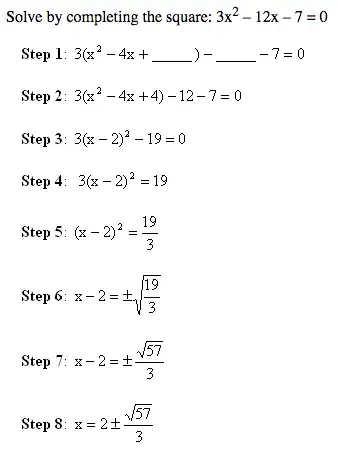Can someone explain what happens from step 6 forward, when solving 3x^2 – 12x – 7 = 0 by completing the square. How does radical of 19/3 turn into radical 57/ 3?
- 37
-
3$19\cdot 3=57$. The person who wrote this decided to rationalize the denominator. – May 26 '15 at 03:28
-
1A friendly reminder that you may always "add zero" or "multiply by one" and it will not change anything. The trick is what "zero" or what "one" you use. Take the very first step for example. Step zero might have rather looked like $3x^2-12x + (12-12) - 7 = 0$. Step 6.5 might have looked like $x-2 = \pm \frac{\sqrt{19}}{\sqrt{3}}\cdot (\frac{\sqrt{3}}{\sqrt{3}})$, noting that $(12-12)=0$ and that $(\frac{\sqrt{3}}{\sqrt{3}}) = 1$ – JMoravitz May 26 '15 at 03:38
2 Answers
This has nothing to do with completing the square. Your confusion is in "rationalizing the demoninator" (usually a square root--but that need not be the case).
In your case you have $\frac{\sqrt{19}}{\sqrt{3}}$. We would "like" to get rid of the divide by an irrational number (although this is an unnecessary step introduced largely for arbitrary reasons by high school math teachers--but it does teach you some properties of fractional powers). To get rid of it, we simply multiply by a special form of "1":
$$ \frac{\sqrt{19}}{\sqrt{3}}*\frac{\sqrt{3}}{\sqrt{3}} = \frac{\sqrt{3*19}}{\sqrt{3*3}} = \frac{\sqrt{57}}{3} $$
That simplification has nothing to do with completing the square--it's just a simplification which would have been just as correct to leave it out and keep the answer as:
$$ 2 \pm \sqrt{\frac{19}{3}} $$
Another Example of Rationalizing the denominator:
I don't like it when you see nothing but square roots. Here's another example:
$$ \frac{1}{\sqrt[3]{2}} $$
We don't multiply by $\frac{\sqrt[3]{2}}{\sqrt[3]{2}}$ because this doesn't rationalize the denominator...we need to get a whole value for $2$:
$$ \frac{1}{\sqrt[3]{2}} * \frac{\sqrt[3]{2^2}}{\sqrt[3]{2^2}} = \frac{\sqrt[3]{4}}{\sqrt[3]{2^3}} = \frac{\sqrt[3]{4}}{2} $$
Had it been $\frac{1}{\sqrt[3]{4}}$ then we could have either done $\frac{1}{\sqrt[3]{4}}*\frac{\sqrt[3]{16}}{\sqrt[3]{16}} = \frac{\sqrt[3]{2^4}}{4} = \frac{\sqrt[3]{2^3*2}}{4} = \frac{2*\sqrt[3]{2}}{4} = \frac{\sqrt[3]{2}}{2}$ or we could already recognize that $\sqrt[3]{4} = \sqrt[3]{2^2}$ which is only lacking a $\sqrt[3]{2}$:
$$ \frac{1}{\sqrt[3]{4}}*\frac{\sqrt[3]{2}}{\sqrt[3]{2}} = \frac{\sqrt[3]{2}}{2} $$
- 6,227
Multiply numerator and denominator by $\sqrt{3}$ and you get
$$\sqrt{\frac{19}{3}}=\frac{\sqrt{57}}{3}$$
- 16,773
-
-
Is it because in the standard form you cannot have a radical in the denominator? – Rndpbs May 26 '15 at 03:32
-
Not to have radicals in the denominator so numbers look like $p+q\sqrt{•}$ where $p$ and $q$ are rationals $\mathbb{Q}[\sqrt{•}]$ is a field – marwalix May 26 '15 at 03:32
-
2OP is asking about completing the square and you're talking about field theory? LOL. – May 26 '15 at 03:33
-
This is the reason besides "why not" that historically rationalizing denominators was explored. It was to show that the inverse of $p+q\sqrt{•}$ is of the same form – marwalix May 26 '15 at 03:35
-
1I have to completely agree with Bye_World. It is more of an aesthetic thing. Just like how some people prefer to write $\frac{1}{\sqrt{2}}$ over $\frac{\sqrt{2}}{2}$. – MathNewbie May 26 '15 at 03:36
-
@Bye_World Actually the OP is confused about step 6, which is a simplification (which rationalizes the denominator) and has nothing to do really with completing the square. – Jared May 26 '15 at 03:48
-